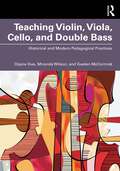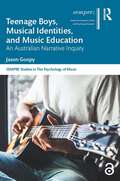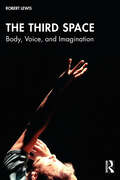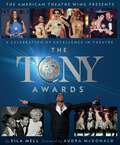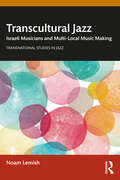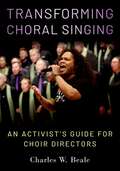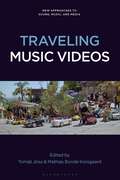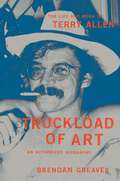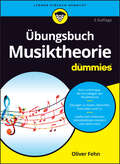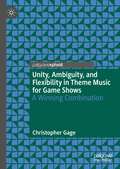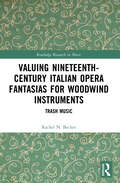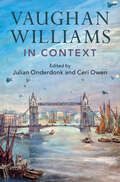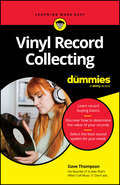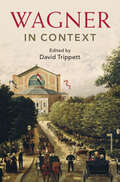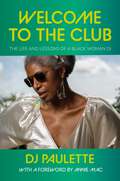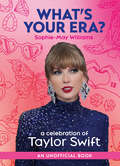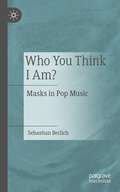- Table View
- List View
Teaching Violin, Viola, Cello, and Double Bass: Historical and Modern Pedagogical Practices
by Dijana Ihas Miranda Wilson Gaelen McCormickTeaching Violin, Viola, Cello, and Double Bass summarizes three centuries of string pedagogy treatises to create a comprehensive resource on methods and approaches to teaching all four bowed string instruments. Co-written by three performance and pedagogy experts, each specializing in different string instruments, this book is applicable to all levels of instruction.Essays on historical pedagogues are clearly structured to allow for easy comprehension of their philosophies, pedagogical practices, and unique contributions. This book concludes with a section on application through comparative analysis of the historical methods and approaches.With coverage from the eighteenth century to the present, this book will be invaluable for teachers and students of string pedagogy and general readers who wish to learn more about string pedagogy’s rich history, diverse content, and modern developments.
Teaching Violin, Viola, Cello, and Double Bass: Historical and Modern Pedagogical Practices
by Dijana Ihas Miranda Wilson Gaelen McCormickTeaching Violin, Viola, Cello, and Double Bass summarizes three centuries of string pedagogy treatises to create a comprehensive resource on methods and approaches to teaching all four bowed string instruments. Co-written by three performance and pedagogy experts, each specializing in different string instruments, this book is applicable to all levels of instruction.Essays on historical pedagogues are clearly structured to allow for easy comprehension of their philosophies, pedagogical practices, and unique contributions. This book concludes with a section on application through comparative analysis of the historical methods and approaches.With coverage from the eighteenth century to the present, this book will be invaluable for teachers and students of string pedagogy and general readers who wish to learn more about string pedagogy’s rich history, diverse content, and modern developments.
Teenage Boys, Musical Identities, and Music Education: An Australian Narrative Inquiry (ISSN)
by Jason GoopyMusic is a powerful process and resource that can shape and support who we are and wish to be. The interaction between musical identities and learning music highlights school music education’s potential contributions and responsibilities, especially in supporting young people’s mental health and well-being. Through the distinctive stories and drawings of Aaron, Blake, Conor, Elijah, Michael, and Tyler, this book reveals the musical identities of teenage boys in their final year of study at an Australian boys’ school.This text serves as an interface between music, education, and psychology using narrative inquiry. Previous research in music education often seeks to generalise boys, whereas this study recognises and celebrates the diverse individual voices of students where music plays a significant role in their lives. Adolescent boys’ musical identities are examined using the theories of identity work and possible selves, and their underlying music values and uses are considered important guiding principles and motivating goals in their identity construction. A teaching and learning framework to shape and support multiple musical identities in senior secondary class music is presented.The relatable and personal stories in this book will appeal to a broad readership, including music teachers, teacher educators, researchers, and readers interested in the role of music in our lives. Creative and arts-based research methods, including narrative inquiry and innovative draw and tell interviews, will be particularly relevant for research method courses and postgraduate research students.
Teenage Boys, Musical Identities, and Music Education: An Australian Narrative Inquiry (ISSN)
by Jason GoopyMusic is a powerful process and resource that can shape and support who we are and wish to be. The interaction between musical identities and learning music highlights school music education’s potential contributions and responsibilities, especially in supporting young people’s mental health and well-being. Through the distinctive stories and drawings of Aaron, Blake, Conor, Elijah, Michael, and Tyler, this book reveals the musical identities of teenage boys in their final year of study at an Australian boys’ school.This text serves as an interface between music, education, and psychology using narrative inquiry. Previous research in music education often seeks to generalise boys, whereas this study recognises and celebrates the diverse individual voices of students where music plays a significant role in their lives. Adolescent boys’ musical identities are examined using the theories of identity work and possible selves, and their underlying music values and uses are considered important guiding principles and motivating goals in their identity construction. A teaching and learning framework to shape and support multiple musical identities in senior secondary class music is presented.The relatable and personal stories in this book will appeal to a broad readership, including music teachers, teacher educators, researchers, and readers interested in the role of music in our lives. Creative and arts-based research methods, including narrative inquiry and innovative draw and tell interviews, will be particularly relevant for research method courses and postgraduate research students.
The Third Space: Body, Voice, and Imagination
by Robert LewisThe Third Space serves a crucial need for contemporary performers by providing an interdisciplinary and physiovocal approach to training. It is a new take on body and voice integration designed to develop the holistic performer. It takes performers through a series of step-by-step practical physiovocal exercises that connects the actor’s centre to the outside world, which increases awareness of self and space. It also develops a deeper connection between spaces within the body and the environment by connecting sound, imagination, and movement.Robert Lewis’s approach is a way of working that unlocks the imagination as well as connecting performers to self, space, and imagination, through voice and body. It conditions, controls, and engages performers by integrating various voice and movement practices.The theories and practice are balanced throughout by: introducing the practical works theoretical underpinnings through research, related work, and case studies of performances; demonstrating a full program of exercises that helps performers get in touch with their centre, their space, and shape both within and outside the body; and exploring the performers physiovocal instrument and its connection with imagination, energies, and dynamics. This book is the result of nearly 20 years of research and practice working with voice and movement practitioners across the globe to develop training that produces performers that are physiovocally ready to work in theatre, screen, and emergent technologies.
The Third Space: Body, Voice, and Imagination
by Robert LewisThe Third Space serves a crucial need for contemporary performers by providing an interdisciplinary and physiovocal approach to training. It is a new take on body and voice integration designed to develop the holistic performer. It takes performers through a series of step-by-step practical physiovocal exercises that connects the actor’s centre to the outside world, which increases awareness of self and space. It also develops a deeper connection between spaces within the body and the environment by connecting sound, imagination, and movement.Robert Lewis’s approach is a way of working that unlocks the imagination as well as connecting performers to self, space, and imagination, through voice and body. It conditions, controls, and engages performers by integrating various voice and movement practices.The theories and practice are balanced throughout by: introducing the practical works theoretical underpinnings through research, related work, and case studies of performances; demonstrating a full program of exercises that helps performers get in touch with their centre, their space, and shape both within and outside the body; and exploring the performers physiovocal instrument and its connection with imagination, energies, and dynamics. This book is the result of nearly 20 years of research and practice working with voice and movement practitioners across the globe to develop training that produces performers that are physiovocally ready to work in theatre, screen, and emergent technologies.
The Tony Awards: A Celebration of Excellence in Theatre
by Eila Mell The American Theatre WingCommemorating over 75 years of Broadway greatness with never-before told stories, rare photos from the American Theatre Wings' archives, and interviews with major honorees like Lin-Manuel Miranda, Patti LuPone, and Hugh Jackman, The Tony Awards is the official, authorized guide to Broadway's biggest night.The Tony Awards: A Celebration of Excellence in Theatre pays tribute to the magic that happens when the curtain goes up and Broadway's best and brightest step onto center stage. Supported by the American Theatre Wing, the arts organization that founded the Tony Awards in 1947 and continues to produce the Tony Awards live telecast each year, author Eila Mell has interviewed a cavalcade of past and present Tony winners, including actors, producers, writers, costume designers, and many many others. Their voices fill the pages of this book with fascinating, behind-the-scenes stories about what it's like to win the theatre world's highest honor. Featuring a foreword by Audra McDonald and over 400 color and black-and-white photographs, The Tony Awards also spotlights more than 130 captivating interviews with a parade of industry insiders, including: Mel Brooks, Matthew Broderick, Carol Burnett, Kristin Chenoweth, Glenn Close, James Corden, Bryan Cranston, Neil Patrick Harris, Jennifer Holliday, Hugh Jackman, John Kander, Angela Lansbury, Judith Light, Hal Linden, Kenny Leon, Patti LuPone, Lin-Manuel Miranda, Brian Stokes Mitchell, Rita Moreno, Bernadette Peters, Chita Rivera, Martin Short, Tom Stoppard, Julie Taymor, Leslie Uggams, and Sir Andrew Lloyd Webber.
Transcultural Jazz: Israeli Musicians and Multi-Local Music Making
by Noam LemishTranscultural Jazz: Israeli Musicians and Multi-Local Music Making studies jazz performance and composition through the examination of the transcultural practices of Israeli jazz musicians and their impact globally. An impressive number of Israeli jazz performers have received widespread exposure and worldwide acclaim, creating music that melds aspects of American jazz with an array of Israeli, Jewish and Middle Eastern influences and other non-Western musical traditions. While each musician is developing their own approach to musical transculturation, common threads connect them all. Unraveling and analyzing these entangled sounds and related discourses lies at the center of this study. This book provides broad insight into the nature, role and politics of transcultural music making in contemporary jazz practice. Focusing on a particular group of Israeli musicians to enhance knowledge of modern Israeli society, culture, discourses and practices, the research and analyses presented in this book are based on extensive fieldwork in multiple sites in the United States and Israel, and interviews with musicians, educators, journalists, producers and scholars. Transcultural Jazz is an engaging read for students and scholars from diverse fields such as: jazz studies, ethnomusicology, Jewish studies, Israel studies and transnational studies.
Transcultural Jazz: Israeli Musicians and Multi-Local Music Making
by Noam LemishTranscultural Jazz: Israeli Musicians and Multi-Local Music Making studies jazz performance and composition through the examination of the transcultural practices of Israeli jazz musicians and their impact globally. An impressive number of Israeli jazz performers have received widespread exposure and worldwide acclaim, creating music that melds aspects of American jazz with an array of Israeli, Jewish and Middle Eastern influences and other non-Western musical traditions. While each musician is developing their own approach to musical transculturation, common threads connect them all. Unraveling and analyzing these entangled sounds and related discourses lies at the center of this study. This book provides broad insight into the nature, role and politics of transcultural music making in contemporary jazz practice. Focusing on a particular group of Israeli musicians to enhance knowledge of modern Israeli society, culture, discourses and practices, the research and analyses presented in this book are based on extensive fieldwork in multiple sites in the United States and Israel, and interviews with musicians, educators, journalists, producers and scholars. Transcultural Jazz is an engaging read for students and scholars from diverse fields such as: jazz studies, ethnomusicology, Jewish studies, Israel studies and transnational studies.
Transforming Choral Singing: An Activist's Guide for Choir Directors
by Charles W. BealeChoral conductors and clinicians often focus on honing the technical and artistic elements of their choir's performance, but what is the true purpose of choral singing? Choral performances sound beautiful, but they also tell stories, "say something" to someone, and create change in them. In that fundamental sense, they are always activist. In Transforming Choral Singing: An Activist's Guide for Choir Directors, author Charles W. Beale draws from his nearly 20 years of leading major choirs in the LGBTQIA+ choral movement internationally as well as his long experience as a singer, organist, conductor, and educator to put forth a new vision for choral singing: to move audiences and change the world. Four main principles underpin this vision: connection, impact, social justice, and stylistic openness. Beale lays down a non-canonical and inclusive framework, grounded in critical musicology and pedagogy, for mission-driven and activist-oriented engagement with the choral arts, and provides practical takeaways for choral practitioners and conductors through a lively mix of practical, rigorous, and fun workshops, tips, and suggestions. Starting from the premise that all styles deserve equal space, the nine chapters cover the core aspects of choral directing, including mission, vocal sound, rhythm and groove, improvising, programming, conducting, and leading a choral community, teaching and learning, and the daily practice of equity and inclusion. The book closes with a series of calls to action and lays out a potentially transformative activist vision for the whole field, which foregrounds participation and engagement, and conceives of all choral singing as a powerful catalyst for musical and social change. The result is a provocative and contemporary approach to building choral communities with profound implications for why we sing, what we sing, how we sing, and how we conduct, teach, rehearse, and lead a choral community.
Traveling Music Videos (New Approaches to Sound, Music, and Media)
by Tomáš Jirsa and Mathias Bonde KorsgaardTraveling Music Videos offers a new interdisciplinary perspective on how contemporary music videos travel across, shape, and transform various media, online platforms, art institutions, and cultural industries worldwide. With the onset of digital technologies and the proliferation of global video-sharing websites at the beginning of the 21st century, music video migrated from TV screens to turn instead to the internet, galleries, concert stages, and social media. As a result, its aesthetics, technological groundings, and politics have been radically transformed. From the kinaesthetic experience of TikTok to the recent reimaginations of maps and navigation tools through music video cartographies, from the ecofeminist voices mediated by live-stream concerts to the transmedia logic of video games and VR, from the videos' role in contemporary art galleries to their political interventions -the chapters map the ways music video is continually reconfiguring itself. The volume tracks music video's audiovisual itineraries across different geographies, maps its transmedia routes, and tackles the cultural impact that it has on our current media ecosystem.
Truckload of Art: The Life and Work of Terry Allen—An Authorized Biography
by Brendan GreavesThe definitive, authorized, and first-ever biography of Terry Allen, the internationally acclaimed visual artist and iconoclastic songwriter who occupies an utterly unique position straddling the disparate, and usually distant, worlds of conceptual art and country music. &“People tell me it&’s country music,&” Terry Allen has joked, &“and I ask, &‘Which country?&’&” For nearly sixty years, Allen&’s inimitable art has explored the borderlands of memory, crossing boundaries between disciplines and audiences by conjuring indelible stories out of the howling West Texas wind. In Truckload of Art, author Brendan Greaves exhaustively traces the influences that shaped Allen&’s extraordinary life, from his childhood in Lubbock, Texas, spent ringside and sidestage at the wrestling matches and concerts his father promoted, to his formative art-school years in incendiary 1960s Los Angeles, and through subsequent decades doggedly pursuing his uncompromising artistic vision. With humor and critical acumen, Greaves deftly recounts how Allen built a career and cult following with pioneering independent records like Lubbock (on everything) (1979)—widely considered an archetype of alternative country—and multiyear, multimedia bodies of richly narrative, interconnected art and theatrical works, including JUAREZ (ongoing since 1968), hailed as among the most significant statements in the history of American vernacular music and conceptual art. Drawing on hundreds of revealing interviews with Allen himself, his family members, and his many notable friends, colleagues, and collaborators—from musicians like David Byrne and Kurt Vile to artists such as Bruce Nauman and Kiki Smith—and informed by unprecedented access to the artist&’s home, studio, journals, and archives, Greaves offers a poetic, deeply personal portrait of arguably the most singularly multivalent storyteller of the American West.
Übungsbuch Musiktheorie für Dummies (Für Dummies)
by Oliver FehnWenn der Stoff sitzen soll, muss man die Theorie auch mal praktisch angehen. Denn auch bei der Musiktheorie hilft vor allem Üben, Üben, Üben. Dieses Buch enthält abwechslungsreiche Übungen, kurzweilige Multiple-Choice-Tests, hilfreiche Eselsbrücken und viele Tipps und Tricks, die Ihnen helfen, Ihr musiktheoretisches Wissen zur Perfektion zu bringen. Sie finden kompakte Erklärungen der wichtigsten musiktheoretischen Grundlagen und natürlich ausführliche Lösungen zu den zahlreichen Übungen. Viele der Übungen und Lösungen gibt es außerdem zum Anhören als Download. Sie erfahren Wie Sie Ihr musiktheoretisches Wissen durch Übungen zu Noten, Akkorden, Intervallen, Tonleitern, Tonarten und Co. vertiefen Wie Sie Musik notieren und spielen Wie Sie Ihr Lieblingsstück in eine andere Tonart transponieren
Unity, Ambiguity, and Flexibility in Theme Music for Game Shows: A Winning Combination
by Christopher GageWith flashing lights, bright colors, and big money, game shows have been an integral part of American culture since the days of radio. While the music that accompanies game shows is charming and catchy, it presents two unique, opposing challenges: first, it must exhibit unity in its construction so that, at any point and for any length of time, it is a tuneful, recognizable signifier of the show to which it belongs; at the same time, it must also possess the ability to be started and stopped according to the needs of gameplay without seeming truncated. This book argues that game show music, in particular from 1960 to 1990, deploys a variety of shared techniques in order to manage these two goals, including theme-derived vamps; saturation of motivic material; and harmonic, rhythmic, and formal ambiguity. Together, these techniques make game show themes exciting, memorable, and perfectly suited to their role.
Valuing Nineteenth-Century Italian Opera Fantasias for Woodwind Instruments: Trash Music (Routledge Research in Music)
by Rachel N. BeckerThis book approaches opera fantasias – instrumental works that use themes from a single opera as the body of their virtuosic and flamboyant material – both historically and theoretically, concentrating on compositions for and by woodwind-instrument performers in Italy in the nineteenth century.Important overlapping strands include the concept of virtuosity and its gradual demonization, the strong gendered overtones of individual woodwind instruments and of virtuosity, the distinct Italian context of these fantasias, the presentation and alteration of opera narratives in opera fantasias, and the technical and social development of woodwind instruments. Like opera itself, the opera fantasia is a popular art form, stylistically predictable yet formally flexible, based heavily on past operatic tradition and prefabricated materials. Through archival research in Italy, theoretical analysis, and exploration of European cultural contexts, this book clarifies a genre that has been consciously stifled and societal resonances that still impact music reception and performance today.
Valuing Nineteenth-Century Italian Opera Fantasias for Woodwind Instruments: Trash Music (Routledge Research in Music)
by Rachel N. BeckerThis book approaches opera fantasias – instrumental works that use themes from a single opera as the body of their virtuosic and flamboyant material – both historically and theoretically, concentrating on compositions for and by woodwind-instrument performers in Italy in the nineteenth century.Important overlapping strands include the concept of virtuosity and its gradual demonization, the strong gendered overtones of individual woodwind instruments and of virtuosity, the distinct Italian context of these fantasias, the presentation and alteration of opera narratives in opera fantasias, and the technical and social development of woodwind instruments. Like opera itself, the opera fantasia is a popular art form, stylistically predictable yet formally flexible, based heavily on past operatic tradition and prefabricated materials. Through archival research in Italy, theoretical analysis, and exploration of European cultural contexts, this book clarifies a genre that has been consciously stifled and societal resonances that still impact music reception and performance today.
Vaughan Williams in Context (Composers in Context)
by Julian Onderdonk Ceri OwenChallenging residual doubts about Vaughan Williams's role and significance within twentieth-century music and culture, this book places and explores his life and music in their broad musical, cultural, social, and political contexts. Chapters by scholars from a range of disciplines re-evaluate the composer's life and career within a world marked by both rapid change and refigured traditions. Building on scholarship that has established Vaughan Williams as aesthetically and politically progressive, the book furthers a revisionist perspective by broadening understandings of the nature of his responses to the twentieth century. This portrait of a modern composer emerges not merely by focusing on under-represented interests and pursuits, but also by contextualizing those activities that have been misrepresented as conservative or backward-looking.
Vinyl Record Collecting For Dummies
by Dave ThompsonGet on the vinyl train and learn about this captivating hobby Vinyl Record Collecting For Dummies teaches you how to start a collection, grow your collection, and make that collection sound excellent. You’ll learn how to shop for new, used, and rare records, and how to select the turntable that’s right for you. Learn how to determine a record’s value, build your collection on a budget, and properly store and maintain your records. This handy Dummies guide also gives you the background knowledge you’ll need to hold your own in conversations with vinyl enthusiasts—all about music genres, the pros and cons of vinyl types, how records are made, and even the history of record collecting itself. Now you can start collecting rare records, new releases, and everything in between. Learn the basics of buying records at record shops, secondhand stores, and online Determine the value of your collection and learn how to recognize great deals Select the turntable and sound system that are right for your needs Explore the history of recorded music and learn why people are going wild for vinyl This is the perfect Dummies guide for anyone who’s ready to get swept up in the excitement of collecting vinyl records, including beginners and seasoned collectors.
Vinyl Record Collecting For Dummies
by Dave ThompsonGet on the vinyl train and learn about this captivating hobby Vinyl Record Collecting For Dummies teaches you how to start a collection, grow your collection, and make that collection sound excellent. You’ll learn how to shop for new, used, and rare records, and how to select the turntable that’s right for you. Learn how to determine a record’s value, build your collection on a budget, and properly store and maintain your records. This handy Dummies guide also gives you the background knowledge you’ll need to hold your own in conversations with vinyl enthusiasts—all about music genres, the pros and cons of vinyl types, how records are made, and even the history of record collecting itself. Now you can start collecting rare records, new releases, and everything in between. Learn the basics of buying records at record shops, secondhand stores, and online Determine the value of your collection and learn how to recognize great deals Select the turntable and sound system that are right for your needs Explore the history of recorded music and learn why people are going wild for vinyl This is the perfect Dummies guide for anyone who’s ready to get swept up in the excitement of collecting vinyl records, including beginners and seasoned collectors.
Wagner in Context (Composers in Context)
by David TrippettFew composers embodied wider cultural interests than Wagner or had greater cultural consequences. This is the first collection to examine directly the rich array of intellectual, social and cultural contexts within which Wagner worked. Alongside fresh accounts of historical topics, from spa culture to racial theory, sentient bodies to stage technology, America to Spain, it casts an eye forward to contexts of Wagner's ongoing reception, from video gaming to sound recording, Israel to Friedrich Kittler, and twenty-first century warfare. The collection brings together an international cast of leading authorities and new voices. Its 42 short chapters offer a reader-friendly way into Wagner studies, with authoritative studies of central topics set alongside emerging new fields. It sheds new light on previously neglected individuals such as Minna Wagner, Theodor Herzl and Houston Stewart Chamberlain, and investigates/assesses/examines the global circulation of Wagner's works, his approach to money, and the controversies that continue to accompany him.
Welcome to the club: The life and lessons of a Black woman DJ
by DJ PauletteIn Welcome to the club, Manchester legend DJ Paulette shares the highs, lows and lessons of a thirty-year music career, with help from some famous friends.One of the Haçienda’s first female DJs, Paulette has scaled the heights of the music industry, playing to crowds of thousands all around the world, and descended to the lows of being unceremoniously benched by COVID-19, with no chance of furlough and little support from the government. Here she tells her story, offering a remarkable view of the music industry from a Black woman’s perspective. Behind the core values of peace, love, unity and respect, dance music is a world of exclusion, misogyny, racism and classism. But, as Paulette reveals, it is also a space bursting at the seams with powerful women.Part personal account, part call to arms, Welcome to the club exposes the exclusivity of the music industry while seeking to do justice to the often invisible women who keep the beat going.
Welcome to the club: The life and lessons of a Black woman DJ
by DJ PauletteIn Welcome to the club, Manchester legend DJ Paulette shares the highs, lows and lessons of a thirty-year music career, with help from some famous friends.One of the Haçienda’s first female DJs, Paulette has scaled the heights of the music industry, playing to crowds of thousands all around the world, and descended to the lows of being unceremoniously benched by COVID-19, with no chance of furlough and little support from the government. Here she tells her story, offering a remarkable view of the music industry from a Black woman’s perspective. Behind the core values of peace, love, unity and respect, dance music is a world of exclusion, misogyny, racism and classism. But, as Paulette reveals, it is also a space bursting at the seams with powerful women.Part personal account, part call to arms, Welcome to the club exposes the exclusivity of the music industry while seeking to do justice to the often invisible women who keep the beat going.
What’s Your Era?: A celebration of Taylor Swift
by null Sophie-May WilliamsAre you a Fearless enthusiast or a Reputation-era renegade? Discover which Taylor Swift era you truly belong to with the ultimate guide for any Swiftie. Taylor has enchanted the world with her music and unapologetically authentic persona. This book explores the exciting tapestry of her career, from her country beginnings to her chart-topping pop anthems. A love letter to the woman who created the soundtrack to so many of our lives, What's Your Era? is a deep dive into each album and what they mean in the wider scope of her career. If you're looking to incorporate more of Taylor's energy and style into your life, or simply want to brush up on your Taylor Swift knowledge, this book is your essential companion. With outfit inspiration for each era, quizzes, and Taylor-themed activities, you'll be all set, whether you're hosting the ultimate Taylor Swift party or prepping for one of her concerts.
Who You Think I Am?: Masks in Pop Music
by Sebastian BerlichPop stars are close to us. In their songs, their pictures, their stories on Instagram. What we are looking for is an authentic impression. Real feelings on real faces. But what happens when they cover their face with a mask? Permanently, as a second face. The phenomenon can be found in the mainstream as well as in the underground. The mask does not break with the ideal of authenticity. Rather, depending on how it is staged, it refers to the most diverse discourses, can appear cool or grotesque, become a logo or create anonymity. The essay uses mainly two examples (Sido, Slipknot) to show how the mask constructs the persona of pop stars - and thus reveals structures of pop music.

